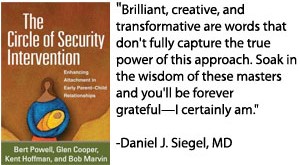
What is Evidence-Based Practice?
The American Psychological Association (APA) has stated that Evidence-based practice in psychology (EBPP) is the integration of the best available research with clinical expertise in the context of patient characteristics, culture, and preferences. The purpose of EBPP is to promote effective psychological practice and enhance public health by applying empirically supported principles of psychological assessment, case formulation, therapeutic relationship, and intervention.
About the Circle of Security® Network
The COS Network provides an evidence-based intervention program for parents and children that focuses on relationships. The Network serves a wide range of families raising children and adolescents across Virginia suffering from disrupted relationships, complex trauma, and attachment difficulties due to developmental issues, reactive attachment disorder, and maltreatment.
How Does it work?
The Network’s assessment and intervention protocols have been scientifically developed and tested . The assessment yields family-specific goals that are incorporated into a service plan. The service plan guides the step-by-step movement through the intervention phases, and identifies specific treatment goals within each phase, as well as overall lynchpin issues. In addition to the intervention goals, the program promotes collaboration with community agencies and other service providers to create comprehensive and integrated services that meet families’ therapeutic needs.
The Network Promotes Agency and Family Needs
- Maintain a child’s placement in a birth, foster, and adoptive home
- Support a smooth transition from residential treatment to home
- Help determine whether or not a current placement can/should be maintained
Click Here to View Intervention Outcomes
Background
The Circle of Security Protocol was specifically designed: to be theory- and research-driven; to be individualized for each dyad [relationship]; to utilize standardized, evidence-based assessment procedures; to yield specific intervention goals based on those assessment procedures; and to focus theinterventions on the caregiver as the partner more likely to induce change. 
Theory, Research, and Expertise Driven
The COS Protocol directly includes many of the ideas reflected in current theory and research in childdevelopment generally, and attachment and early parent–child interaction in particular.Especially important among these are the ideas of emotion regulation; interactivesynchrony; states of mind regarding attachments and intimate relationships; shared states of consciousness, affect, and perspectives; and reflective functioning.
The core constructs for the assessment and intervention components of the protocol are Ainsworth’s ideas of a Secure Base and a Haven of Safety (e.g. Ainsworth, Blehar, Waters, & Wall, 1978). Our goal is to present these ideas to the parents in a ‘user-friendly’, common-sense fashion that is cognitively and emotionally accessible to them, and that also guides the intervention.
Individualized for each Relationship
The intervention is individualized for each of the major patterns, or strategies, of attachment–caregiving interactions and internal working models (IWMs). This is based on differential identification of each child’s attachment pattern and his or her parent’s caregiving pattern, followed by a specific treatment (sub-)protocol assigned to that dyadic pattern. This design optimizes the ‘goodness of fit’ between parent and child, and helps to eliminate the potential problems of a ‘one size fits all’ approach to intervention.
The videotapes and questionnaires from each assessment are coded by clinical psychologists or clinical graduate students appropriately trained and certified in the attachment procedures. The child’s attachment pattern is coded. The parent’s caregiving classification is coded from the same Strange Situation. Intervention goals are derived from the classifications, ratings and clinical observations.
Direct focus on the Caregiver/Parent
In designing the Circle of Security protocol, the originators decided to capitalize on the fact that the caregiver, as an adult, has more ‘degrees of freedom’ in changing patterns of attachment– caregiving interactions than does the child. This focus specifically does not imply that the problematic pattern is ‘caused’ by the caregiver. Rather, the implication is that even for a pre-schooler or an older child, a most effective intervention for problematic attachment–caregiving patterns may be to focus directly on the caregiver, and work toward shifting the caregiver’s patterns of behavior and/or her IWMs of attachment– caregiving interactions with this particular child. This shift should then lead to a change in patterns of parent–child interaction, and in turn shift the child’s patterns of attachment-and exploratory-behavior toward a more adaptive developmental pathway.
THE CIRCLE OF SECURITY® (COS) PROTOCOL
The seminal project -- The 20-week intervention takes place in a small group of five or six caregivers, and one or two therapists. The group sessions are videotaped. The therapist edits key segments of the assessment videotapes for use in the group sessions.
There is a sequence of five overarching therapeutic goals used for all parents:
- Attachment Evaluation
- to create a holding environment or secure base from which the parents can explore their parenting;
- to provide the parents with a user-friendly map of attachment theory that we call the Circle of Security;
- to help the parents develop their observational skills, especially as these apply to reading and responding to their children’s (often subtle and misleading) cues;
- to develop a process of reflective dialogue between therapist and parent – a skill that the parent can then use internally; this process is viewed as the central dynamic for change;
- to supporting the parents’ empathic shift from defensive process to empathy for their children
Click Here to View Intervention Outcomes
The Circle of Security® Network
Individual Family Model (In-Home or Outpatient)
Intervention Phases |
Summary of key service goals identified in the service plan |
Phase I: Assessment |
|
Phases II-VI: Therapy |
|
- Begins with assessment of attachment-caregiving patterns
- Assessment of parents internal working models of close family relationships
- Individualized treatment goals for the family
- Videotape review of video clips
- Education (Reflective Dialogue between parents and therapist) & Psychotherapy (Shark Music Resolution)
- Support and Practice, which leads to consolidation
- Number of weekly sessions varies for each family. The overall target is 12 months for length of service, depending on complexity of the case
Experiential Parent Group Model (Abbreviated)
- 10 sessions with 2 follow-up booster sessions
- Formal assessments of attachment-caregiving patterns are NOT mandatory
- Relies on the use of archived videotape of other dyads to learn and practice COS framework
- Huge focus on “Circle Stories” - this brings their own experiences with their child “into the room”
- There is a strong focus on the child’s cuing, miscuing, and needs around the Circle, and the child’s Shark Music
- Parent and therapist engage in reflective dialogue about parents’ behavior and challenge points
- Therapist focuses on reading the parents’ cues and attending to the parents’ needs around the Circle
- Referral to Family Model for further work, if needed
More about the COS Evidence Base and International Influence